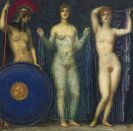
Odilon Redon
1840 Bordeaux
1916 Paris
The painter, etcher and lithographer Odilon Redon was born in Bordeaux on April 20, 1840. The French symbolist is considered the pioneer of modernity, particularly for surrealism. As a seven-year-old, he lived in Paris and went to museums there; that is when he decided to become a painter. Odilon Redon’s work can be divided into two phases, the first one black and the second one in color. In the black phase, charcoal drawings and print graphics were created on the theme of the human subconscious. This was superseded by a phase of great colorfulness. Elements from antiquity and nature appear in an idealized manner of representation.
Redon received his first instruction with the painter Stanislas Gorin de Baux (1820 – around 1865) in Bordeaux. In addition, he had an apprenticeship with the painter Jean-Léon Gérôme (1824 – 1904). He also became acquainted with the botanist Armand Clavaud (1828 – 90) and the graphic artist Rodolphe Bresdin (1822 – 85), who introduced him to graphic techniques. In Paris, Odilon Redon cultivated contacts with Jean-Baptiste Camille Corot (1796 – 1875) and Gustave Courbet (1819 – 77). He was also impressed by Gustave Moreau (1826 – 98) and carried out eager studies in the Louvre.
In 1867, Odilon Redon was represented in the Salon for the first time. In the following year, a notice by the artist was published in "La Gironde". He received a commission in 1870 from the architect Albert Carré to paint a chapel. In 1878, Redon worked with lithography under the guidance of Fantin-Latour. In 1881 he displayed a charcoal drawing from the last year for the first time in "La vie moderne" and in the following year in the hall of the journal "Le Gaulois". In 1884, Redon co-founded the Société des "Artistes Indépendants". The artist also participated in the last exhibition of the Impressionists in the year 1886 and in the exhibition of the Société des Peintres-Graveurs at Durand-Ruel in Paris. Beginning in 1891, he turned with new intensity to color. From 1891 to 1899, the last series of his lithographs appeared.
After Paul Gauguin (1848 – 1903) left for Tahiti in 1891, Odilon Redon became the central point of the young avant-garde painters. He declared in public in 1902 that he would not make any more black-and-white works and that he wanted to devote himself exclusively to color.
Already a year later came the climax of his color production. The famous bouquet, "Flowers", appeared. In the fall Salon, an entire room was devoted to him. The exhibit was a great success. In the following years, portraits were created above all, in which the person is mostly surrounded by flowers, for example in the pastel "Portrait of Violette Heymann" (1910). Flowers play in general a particularly large role in Redon’s production. For example, he presented clouds too as flowers. The older the artist became, the more cheery his color palette.
Odilon Redon died in Paris on July 6, 1916.

Would you like to sell a work by Odilon Redon?
Infos for sellerART MARKET:

Urteil des Paris
Oil on panel, 1922
Estimated price 120.000
More offers >






